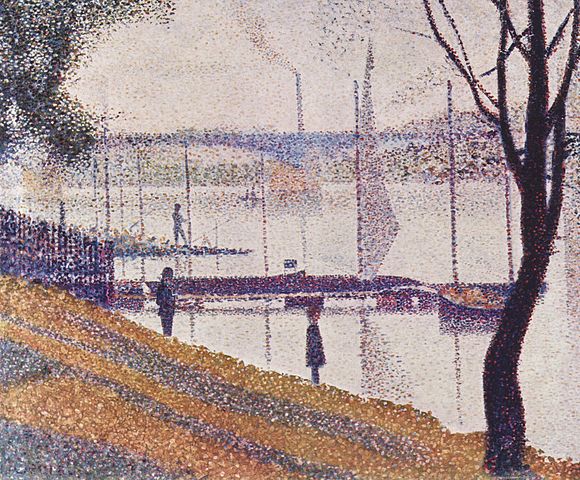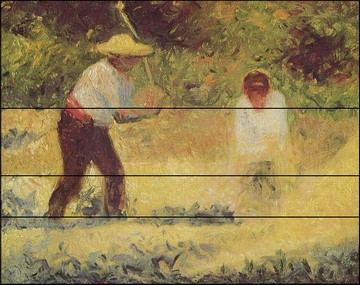Georges Seurat (1859–1891) was a French Post-Impressionist painter, who according to Wikipedia, “is noted for his innovative use of drawing media and for devising the technique of painting known as pointillism.” 
It continues, “His large-scale work A Sunday Afternoon on the Island of La Grande Jatte (1884–1886) altered the direction of modern art by initiating Neo-impressionism. It is one of the icons of late 19th-century painting.”
Did Seurat “attack every canvas with the Golden Ratio?”
The book “Mathematics” by David Bergamini stated that Seurat’s painting “La Parade de Cirque” contains numerous examples of Golden Proportions” and includes a quotation attributed to “one art expert” (identified in the book The Golden Ratio by Dr. Mario Livio as Matila Ghyika) that Seurat “attacked every canvas with the golden ratio.” A very interesting claim indeed, but is it true? Others say it’s but a myth to be dispelled.
Maybe not “every” canvas, but apparently a third or more
There’s also a quotation that says “a picture is worth a thousand words”, so rather than offer another 10,000 or more words on the subject, below are twelve Seurat paintings with golden ratio lines overlayed using PhiMatrix golden ratio design and analysis software. Click on any of them for a larger image with more clarity of the features and lines. Of the 103 Seurat paintings shown at Wikimedia Commons, these 12 below and about 20 more (see page 2) show evidence of at least one significant composition line or element whose placement appears to have been based on a conscious decision to apply the golden ratio.
Golden Ratios on canvas height and width, not arbitrary points
De-constructing an artist’s intent and method of art composition can seem arbitrary when applied to design elements within a painting. In all the paintings analyzed, the golden ratio lines are simply based on the height and width of the canvas to eliminate any possibilities that the dimensions analyzed were based on arbitrary points. Not all of Seurat’s paintings show golden ratios like the ones shown below and the other 20. Accordingly, it may be difficult to conclude that Seurat “attacked every canvas” with golden ratios, but it seems that he used the golden ratio in the basic composition in at least a third of his paintings.
Golden Ratio tools make it easy. Lack of bias makes it accurate.
There are many claims made about whether various artists used the golden ratio, even Leonardo Da Vinci, who created the illustrations for the book “The Divine Proportion” by his contemporary, Luca Pacioli. To make accurate assessments, you need tools that can easily identify golden ratio proportions, and an approach to the search that is unbiased, either for or against, with respect to appearances of the golden ratio. It may be that other golden ratios can be found in the various lines and focal points within many of Seurat’s paintings as well, but I’ll leave that to you the reader to pursue in more depth and to come to your own conclusions. Wikipedia Commons has a good collection of images of the paintings of George Seurat as a great place to start, and PhiMatrix has a free two week trial for you to use in your investigation. Click on any image below for a larger version:
See more detailed analysis on Page 2
Seurat as the Creator of Pointillism
As discussed on page 1 of Georges Seurat and the Golden Ratio in Art Composition, Seurat “is noted for his innovative use of drawing media and for devising the technique of painting known as pointillism.”
Seurat and the Golden Ratio
Seurat is also said by one art expert to have “attacked every canvas with the golden ratio.” Some have claimed this is nothing more than a myth to be debunked. I did my own investigation using PhiMatrix golden ratio design and analysis software, examining the 103 Seurat paintings shown at Wikimedia Commons. To avoid any claims that the results are biased or arbitrary, I based my golden ratio measurements solely on the height and width of the canvas. The paintings selected were based on the appearance of composition lines or elements that seemed to exhibit a conscious decision on the part of Seurat to apply the golden ratio. All golden ratio lines shown are calculated by the software and their placement on the painting is precise to within a pixel on the screen. I found golden ratios on this basis in about one third of Seurat’s paintings. Some may be subject to a little interpretation, but then some that were only close to golden ratios were excluded from the results as well. In addition, I found a number of golden ratios within the key features or elements of the painting themselves, and have included only two examples at the end of this article.
Explore, decide for yourself and learn
The results of this study are shown below. Click on any of the individual images below the slide show for a larger image with more detail and judge for yourself. The first group illustrates Seurat’s application of the golden ratio in horizons and focal points:
This second group illustrates applications of the golden ratio in human form paintings and other subjects that are either more subtle or less precise. Click on any image to review in high resolution:
In other instances, Seurat may have used the golden ratio for composition of elements within a painting rather than basing the composition simply on its height and width. The example below illustrates apparent use of the golden ratio. The painting on the left shows golden ratios of the height and width, which reveal nothing. The painting on the right shows golden ratios that appear to have been used in the positioning of the men and the buildings in relation to the right side of the painting. Many other similar examples can be found in Seurat’s paintings where the artist’s intent seems clear, and not the result of simply searching for golden ratios afterwards.
If Seurat did “attack a canvas with the golden ratio,” we would expect to see golden ratios between elements within the composition and not just based on the simple height and width of the canvas. The painting below shows a number of rather clear and precise applications of the golden ratio. Measure them for yourself though and come to your own conclusions. Golden ratios can be found in:
- The sailboat is positioned in the golden ratio lines between the top and bottom of the painting
- The shoreline at the bottom is positioned at a golden ratio of the width of the painting
- The building on the shore is divided at a golden ratio point
- The height and width of the small sail are golden ratios of the height and width of the large sail
- The width of the small trunk of the tree is a golden ratio of the width of the large trunk of the tree
- The trees on the left horizon are positioned in a golden ratio spacing (it’s also a golden ratio if you use the center line of each tree rather than the highest point)
- The row boat and rower are positioned a a golden ratio point between the sailboat and the bottom of the painting
Click on the thumbnail below and then click on the View Full Size button to see the image in full resolution.
If you have any remaining doubt that Seurat used the golden ratio consider this: About one-quarter of his paintings had dimensions based on golden rectangles.
See more detailed analysis on Page 3
Seurat often painted on golden rectangle canvases and panels
In addition to basing many of his composition decisions on golden ratios, Seurat chose to paint about one-quarter of his work on golden rectangle panels. Of his 103 paintings listed at Wikimedia, at least two dozen of them had a height to width ratio of the golden ratio. Most of these were on small canvases or wood panels. In my analysis I found 25 paintings on golden rectangles with sizes that ranged from 9.4″ to 10.4″ by 5.7″ by 6.8″. Their average variance from a golden ratio was 0.1″. I suppose there are two possibilities here. One is that Seurat intentionally used golden rectangles for these paintings, and just didn’t have or need the tools to cut these panels to a higher yet degree of accuracy. The other is that he intentionally created a panels with a wide range of dimensions all slightly off from the golden ratio and achieved this with amazing accuracy. Which do you suppose is more likely? Given all the other evidence, it seems rather clear that he was incorporating golden ratios in one more creative way. Note in the images below the consistency of proportion in these golden rectangles in landscape orientation.
Here’s another set of his paintings with golden rectangles in portrait orientation:
Seurat may not have attacked every canvas with the golden ratio, but there have been few artists who were more passionate about using the golden ratio in the expression of their art.
A special thanks goes to to John Gury for bringing the golden rectangle dimensions of Seurat’s “Le Jardiner” to my attention. This resulted in my review of these 103 Seurat paintings for golden rectangles in the dimensions of the canvases or panels, and the discovery of these two dozen other examples.
